Ascending Passage .com HOME PAGE.
See the: Egyptian Secrets Library.

The Monuments of Abydos
Abydos (Thnis) is known today as the home of the Temple of Seti - one of the finest and best preserved New Kingdom temples, and also of the Osiron, a strange underground set of chambers built of huge, mostly undecorated stones and quite unlike any other site in Egypt, except to some degree a temple near the Giza Sphinx.
There are a number of other interesting features at Abydos, as this paper prepared by Sir William Flinders Petrie explains.
Modern scholarship has given much more recent dates to the Old Kingdom of Egypt, these modern estimates are given in (parenthesis).
The Monuments of Abydos
by William Flinders Petrie
published in 1911
from: The Gutenberg Encyclopedia
Adapted for AscendingPassage.com.
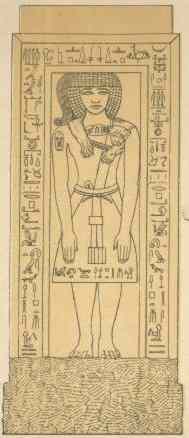 ABYDOS, one of the most ancient cities of Upper Egypt,
about 7 miles West of the Nile in lat. 26 deg. 10' N.
ABYDOS, one of the most ancient cities of Upper Egypt,
about 7 miles West of the Nile in lat. 26 deg. 10' N.
The Egyptian
name was Abdu, the hill of the symbol or reliquary,
in which the sacred head of Osiris was preserved. Thence
the Greeks named it Abydos, like the city on the Hellespont (the Dardanelles, the narrow strait between European and Asiatic Turkey);
the modern Arabic name is Arabet el Madfuneh.
The history
of the city begins in the late prehistoric age, it having
been founded by the pre-Menite kings (Petrie, Abydos,
ii 64), whose town, temple and tombs have been found
there. The kings of the Ist dynasty, and some of the IInd
dynasty, were also buried here, and the temple was renewed
and enlarged by them.
Great forts were built on the desert
behind the town by three kings of the IInd dynasty. The
temple and town continued to be rebuilt at intervals down
to the times of the XXXth dynasty, and the cemetery was used
continuously.
In the XIIth dynasty a gigantic tomb was
cut in the rock by Senwosri (or Senusert) III. Seti I in
the XIXth dynasty founded a great new temple to the south
of the town in honor of the ancestral kings of the early
dynasties; this was finished by Rameses (or Ramessu) II, who
also built a lesser temple of his own. Mineptah (Merenptah)
added a great Hypogeum of Osiris to the temple of Seti. (This attribution is disputed)
The
latest building was a new temple of Nekhtnebf in the XXXth
dynasty. From the Ptolemaic times the place continued to decay
and no later works are known (Petrie, Abydos, i and ii).
The worship here was of the jackal god Upuaut (Ophols,
Wepwoi), who "opened the way" to the realm of the dead,
increasing from the Ist dynasty to the time of the XIIth
dynasty and then disappearing after the XVIIIth. Anher
appears in the XIth dynasty; and Khentamenti, the god of the
western Hades, rises to importance in the middle kingdom and
then vanishes in the XVIIIth. The worship here of Osiris
in his various forms begins in the XIIth dynasty and becomes
more important in later times, so that at last the whole
place was considered as sacred to him (Abydos, ii 47).
The temples successively built here on one site were nine
or ten in number, from the Ist dynasty, 5500 B.C. (now believed to be about 3050 B.C.) to the
XXVIth dynasty, 500 B.C. The first was an enclosure,
about 30X 50 ft., surrounded by a thin wall of unbaked
bricks. Covering one wall of this came the second temple of
about 40 ft. square in a wall about 10 ft. thick. An outer
temenos (enclosure) wall surrounded the ground. This outer
wall was thickened about the IInd or IIIrd dynasty.
The old
temple entirely vanished in the IVth dynasty, and a smaller
building was erected behind it, enclosing a wide hearth of black
ashes. Pottery models of offerings are found in the ashes,
and these were probably the substitutes for sacrifices decreed
by Cheops (Khufu) in his temple reforms.

Offering found at the Osiris Temple
A great clearance of
temple offerings was made now, or earlier, and a chamber full
of them has yielded the fine ivory carvings and the glazed
figures and tiles which show the splendid work of the Ist
dynasty. A vase of Menes with purple inlaid hieroglyphs
in green glaze and the tiles with relief figures are the
most important pieces. The noble statuette of Cheops in
ivory, found in the stone chamber of the temple, gives
the only portrait of this greatest ruler. (In 2016 this still is the only known image of the builder of the Great Pyramid, however Zahi Hawass argues with some cause that it is a much later imitation.)
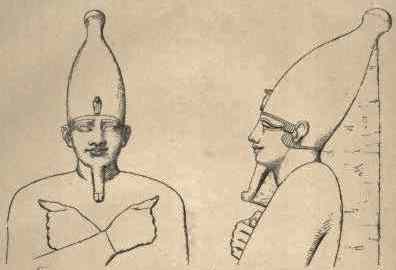 The temple was
rebuilt entirely on a larger scale by Pepi I (2332-2283 B.C.) in the VIth
dynasty. He placed a great stone gateway to the temenos and an
outer temenos wall and gateway, with a colonnade between the
gates. His temple was about 40X50 ft. inside, with stone
gateways front and back, showing that it was of the processional
type.
The temple was
rebuilt entirely on a larger scale by Pepi I (2332-2283 B.C.) in the VIth
dynasty. He placed a great stone gateway to the temenos and an
outer temenos wall and gateway, with a colonnade between the
gates. His temple was about 40X50 ft. inside, with stone
gateways front and back, showing that it was of the processional
type.
In the XIth dynasty Menthotp (Mentuhotep) III (1997-1991 B.C.) added
a colonnade and altars. Soon after, Sankhkere entirely
rebuilt the temple, laying a stone pavement over the area,
about 45 ft. square, besides subsidiary chambers. Soon after
Senwosri (Senusert) I in the XIIth dynasty laid massive
foundations of stone over the pavement of his predecessor. A
great temenos was laid out enclosing a much larger area, and
the temple itself was about three times the earlier size.
The XVIIIth dynasty began with a large chapel of Amasis
(Ahmosi, Aahmes) I, and then Tethmosis (Thothmes, Tahutmes)
III built a far larger temple, about 130X200 ft. He made
also a processional way past the side of the temple to the
cemetery beyond, with a great gateway of granite.
Rameses III (1183-1152 B.C.)
added a large building; and Amasis II (570 - 526 B.C.) in the XXVIth dynasty
rebuilt the temple again, and placed in it a large monolith
shrine of red granite, finely wrought. The foundations of
the successive temples were comprised within about 18 ft.
depth of ruins; these needed the closest examination to
discriminate the various buildings, and were recorded by over
4000 measurements and 1000 levellings (Petrie, Abydos, ii).
(The Ancient Temple of Osiris today lies below a modern town and thus is mostly unavailable to archeology. This may not be all bad, techniques continue to improve and there should be some undisturbed sites for scientists of future centuries.)

Seti's Temple at Abydos
Photograph by Henri Bechard 1887
The Temple of Seti I (1294-1279 B.C.) was built on entirely new ground
half a mile to the south of the long series of temples just
described. This is the building best known as the Great
Temple of Abydos, being nearly complete and an impressive
sight.
A principal object of Seti's Temple was the adoration of the early
kings, whose cemetery, to which it forms a great funerary
chapel, lies behind it. The long list of the kings of the
principal dynasties carved on a wall is known as the "Table
of Abydos."
There were also seven chapels for the worship of
the Pharaoh and principal gods. At the back were large chambers
connected with the Osiris worship (Caulfield, Temple of the
Kings); and probably from these led out the great Hypogeum (the Osiron)
for the celebration of the Osiris mysteries, built by Mineptah
(Osirion at Abydos by Murray).
The temple of Seti was originally 550 ft. long,
but the forecourts are scarcely recognizable, and the part in
good state is about 250 ft. long and 350 ft. wide, including
the wing at the side. Excepting the list of kings and a
panegyric on Rameses II, the subjects are not historical but
mythological. The work is celebrated for its delicacy and
refinement, but lacks the life and character of that in earlier
ages. The sculptures have been mostly published in hand copy,
not facsimile, by Mariette in his Abydos, i.
The adjacent
Temple of Rameses II (1279-1213 B.C.) was much smaller and simpler in plan; but
it had a fine historical series of scenes around the outside,
of which the lower parts remain. A list of kings, similar
to that of Seti, formerly stood here; but the fragments were
removed by the French consul and sold to the British Museum.

Many of the limestone blocks of the Temple of Ramsses were burned to make cement, leaving only the lowest courses.

Plan of Ramsses II's Temple at Abydos.
Auguste Mariette Expedition 1869
The Royal Tombs of the earliest dynasties were placed about
a mile back on the great desert plain. The earliest is about
10X20ft. inside, a pit lined with brick walls, and originally
roofed with timber and matting. Others also before Menes
are 15X25 ft. The tomb probably of Menes (c. 3050 B.C.) is of the latter
size.


Tombs of early Pharaohs
After this the tombs increase in size and complexity.
The tomb-pit is surrounded by chambers to hold the offerings,
the actual sepulchre being a great wooden chamber in the
midst of the brick-lined pit. Rows of small tomb-pits for the
servants of the king surround the royal chamber, many dozens
of such burials being usual.
By the end of the IInd dynasty
the type changed to a long passage bordered with chambers
on either hand, the royal burial being in the middle of the
length. With its dependencies it covered a space of over 3000 square yards.
The contents of
the tombs have been nearly destroyed by successive plunderers;
enough remained to show that rich jewellery was placed on the
mummies, a profusion of vases of hard and valuable stones
from the royal table service stood about the body, the
store-rooms were filled with great jars of wine, perfumed
ointment and other supplies, and tablets of ivory and of
ebony were engraved with a record of the yearly annals of the
reigns.
The sealings of the various officials, of which
over 200 varieties have been found, give an insight into
the public arrangements (Petrie, Royal Tombs, i. and ii).
The cemetery of private persons begins in the Ist dynasty with
some pit tombs in the town. It was extensive in the XIIth
and XIIIth dynasties and contained many rich tombs. In the
XVIIIth-XXth dynasties a large number of fine tombs were made,
and later ages continued to bury here till Roman times.
Many
hundred funeral steles were removed by Mariette's workmen,
without any record of the burials (Mariette, Abydos, ii. and
iii). Later excavations have been recorded by Ayrton, Abydos,
iii.; Maclver, El Amrah and Abydos; and Garstang, El Arabah.
Stele are flat carved stones, similar to tombstones, although they do not always mark graves. Here are some of those gathered by Mariette:
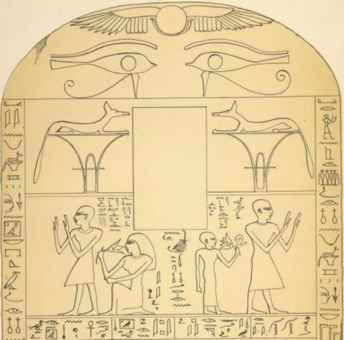
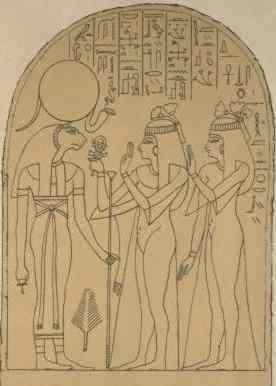
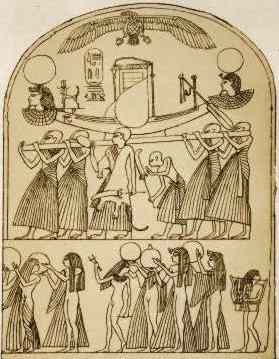
The "forts" lay behind the town. (These are rough stone or brick enclosures now considered tombs.) That known as Shunet el
Zebib is about 450X250 ft. over all, and still stands 30 ft.
high. It was built by Rhasekhemui (Khasekhemwy), the last king of the IInd
dynasty around 2700 BC.

Bronze bowl and ewer. (British Museum)
Found in the tomb of Khasekhemwy,
these mark the beginnings of the bronze age in Egypt.
Bronze chisels make dressed (squared) stone buildings practical.
The greatest achievements of Egypt
were created without iron.
Photograph from EgyptArchive.
Another fort nearly as large adjoined it, and
is probably rather older. A third fort of a squarer form
is now occupied by the Coptic convent; its age cannot
be ascertained (Ayrton, Abydos, iii).
The Monuments of Abydos
by William Flinders Petrie, 1911.
At least 14 brick lined pits have been discovered near the funerary enclosure of Pharaoh Khasekhemwy in Abydos, each holding a 60 to 80 foot (18 - 25 meter) wooden boat from the first or second Dynasty. First found in 1991, excavation and conservation of these boats is continuing.

The discovery of the Osirion is discussed
by Sir William Flinders Petrie and Margaret Alice Murray in:
The Osirion at Abydos
Seti's Great Temple at Abydos
Countless beautiful 19th century images of ancient Egypt
and 75 pages of architecture, art and mystery
are linked from the library page:

The Egyptian Secrets Library



 ABYDOS, one of the most ancient cities of Upper Egypt,
about 7 miles West of the Nile in lat. 26 deg. 10' N.
ABYDOS, one of the most ancient cities of Upper Egypt,
about 7 miles West of the Nile in lat. 26 deg. 10' N.
 The temple was
rebuilt entirely on a larger scale by Pepi I (2332-2283 B.C.) in the VIth
dynasty. He placed a great stone gateway to the temenos and an
outer temenos wall and gateway, with a colonnade between the
gates. His temple was about 40X50 ft. inside, with stone
gateways front and back, showing that it was of the processional
type.
The temple was
rebuilt entirely on a larger scale by Pepi I (2332-2283 B.C.) in the VIth
dynasty. He placed a great stone gateway to the temenos and an
outer temenos wall and gateway, with a colonnade between the
gates. His temple was about 40X50 ft. inside, with stone
gateways front and back, showing that it was of the processional
type.










